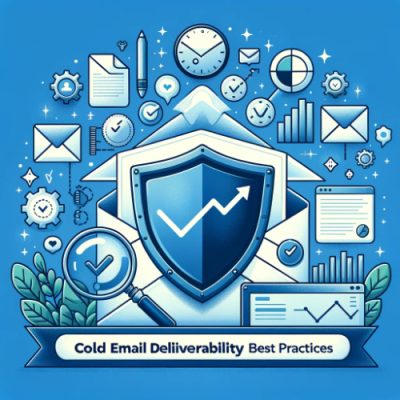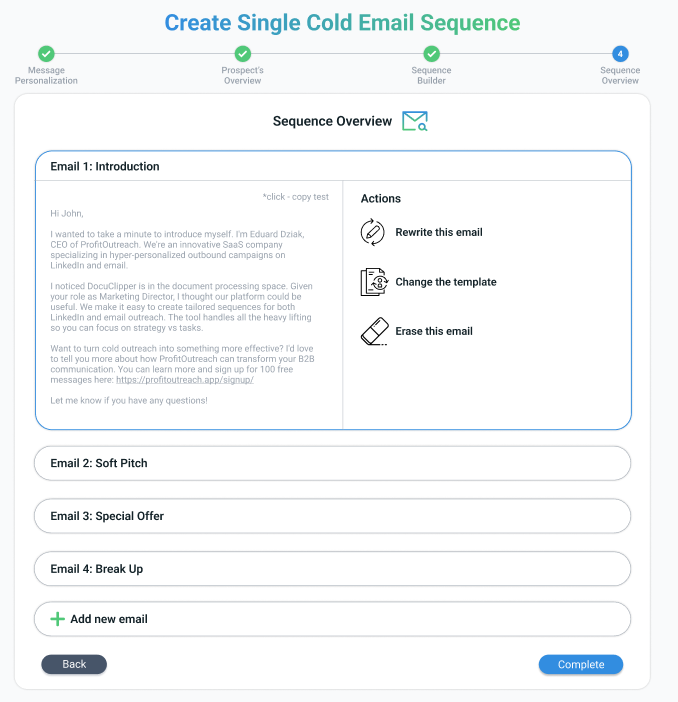Cold email deliverability is the cornerstone of successful email marketing strategies, enabling businesses to reach potential clients, partners, or customers effectively.
It hinges on the ability of an email to land in the recipient’s inbox, bypassing spam filters and avoiding rejections.
With the right practices, your business can significantly enhance your outreach efforts, ensuring your messages are not only delivered but also read and acted upon.
This guide dives deep into the essential practices for optimizing cold email deliverability, offering insights to marketers aiming to improve their campaign’s impact and success rate.
What is Cold Email Deliverability?

Cold email deliverability refers to the ability of an email to successfully reach the recipient’s inbox without being filtered out as spam or rejected by email servers.
It’s a crucial metric for marketers and businesses who rely on cold emailing as a strategy to reach potential clients, partners, or customers who have not previously interacted with their brand.
Deliverability focuses on various factors, including the sender’s reputation, email content quality, and adherence to email authentication protocols.
In essence, cold email deliverability determines the visibility and potential impact of your outreach efforts, directly influencing the success rate of your cold email strategies.
What’s Good Email Deliverability Rate?
A good email deliverability rate is crucial for the success of any email marketing campaign, especially cold emailing.
The average email deliverability rate stands at 85.7%. However, with 4.3% of emails never reaching the intended inbox, 6.3% landing in spam folders, and an 8% undelivered rate, there’s significant room for improvement. (cold email statistics)
At ProfitOutreach, we recommend aiming for an email deliverability rate above 90%, with an optimal target of 95%.

Achieving this higher benchmark ensures that your cold emails not only reach your audience but also significantly reduce the risk of being marked as spam, thereby increasing the effectiveness of your cold email campaigns.
Why is Cold Email Deliverability So Important?
Cold email deliverability is a critical component of your cold email marketing success, underscored by the fact that 61% of marketers identify improving email deliverability rates as a significant challenge.
This importance comes from several key reasons such as:
- Direct Impact on Campaign Success: High deliverability rates ensure that your cold emails reach the intended recipients’ inboxes, directly influencing the cold email open rates and cold email response rates of your campaigns.
- Brand Reputation: Consistently high deliverability rates help maintain and enhance your sender reputation, making future emails more likely to be successfully delivered, opened, and acted upon.
- Efficiency and Cost-Effectiveness: By maximizing the number of emails that reach the inbox, you optimize your return on investment, ensuring that your efforts and resources are not wasted on emails that never get seen.
- Compliance and Trust: Adhering to best practices for email deliverability demonstrates respect for regulations and recipient preferences, building trust with your audience.
In essence, cold email deliverability is not just about avoiding spam filters; it’s about ensuring your message is heard, building a positive brand image, and maximizing the effectiveness of your outreach efforts. It’s one of the most critical cold email KPIs to monitor.
Factors Affecting Cold Email Deliverability
There are multiple factors that will affect your cold email deliverability and with that the success rate of your cold emails reaching the intended inboxes and understanding these can significantly enhance your email deliverability:
- Email Authentication Methods: Implementing SPF (Sender Policy Framework), DKIM (DomainKeys Identified Mail), and DMARC (Domain-based Message Authentication, Reporting, and Conformance) helps verify your emails’ legitimacy, reducing the likelihood of being marked as spam.
- Importance of a Clean Email List: Regularly cleaning your email list to remove invalid or unengaged addresses minimizes bounce rates and protects your sender reputation.
- Role of Sender Reputation: ISPs and email services evaluate your sending habits and history. A good reputation increases your emails’ chances of bypassing spam filters.
- Content Quality: High-quality, relevant content is less likely to trigger spam filters. Avoiding spammy phrases and ensuring your message provides value is crucial.
- Age of Domain: Older domains are often deemed more trustworthy than newly registered ones, affecting deliverability.
- Bounces & Rejections: High rates of email bounces and rejections can harm your sender reputation, leading to future emails being blocked or filtered into spam.
Addressing these factors effectively can lead to a significant improvement in your cold email campaigns’ deliverability rates.
But don’t sweat as we’re going to address all these and more later on as well as cold email software will help you to set up the essential technical aspects of your cold emails.
Best Practices for Improving Cold Email Deliverability
Alright, now that you understand the basics of cold email deliverability let’s focus on the most important part of this article and that is to ensure your cold emails land in the inbox, get open, read, replied to, and drive the action you want them to.
Additionally, we recommend to also read our article about cold email vs spam email to further improve your deliverability rate.
By staying informed about cold email trends, you can adapt your approach to maintain high deliverability rates.
So here are 19 cold email deliverability best practices as well ass some of my cold email tips:
1. Warm Up Your Domain Before Sending Cold Emails
Warming up your domain is a critical first step before launching cold email campaigns. This process involves gradually increasing the volume of emails sent from a new domain over time, helping to establish a positive sending reputation with Internet Service Providers (ISPs).
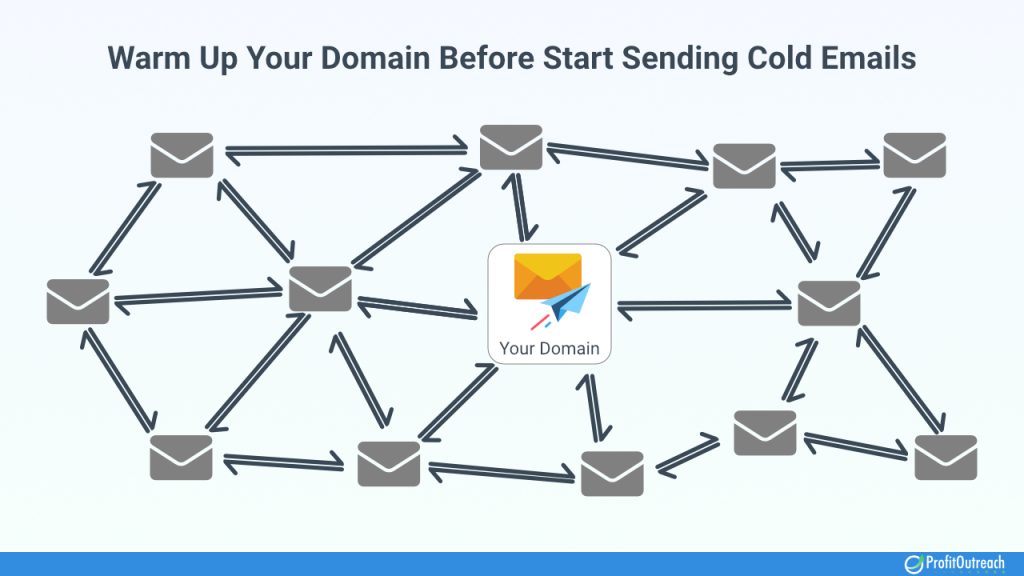
Starting with a low volume and slowly scaling up allows ISPs to recognize your domain as a legitimate sender, reducing the risk of your emails being marked as spam.
It mimics the natural way of sending emails as when an employee joins a company, at first they send very few emails and gradually they send more and more emails.
2. Create Specific Cold Email Domain (Very Similar to Yours)
Using a specific domain for cold emailing, closely related to your main domain, can safeguard your primary domain’s reputation and enhance deliverability.
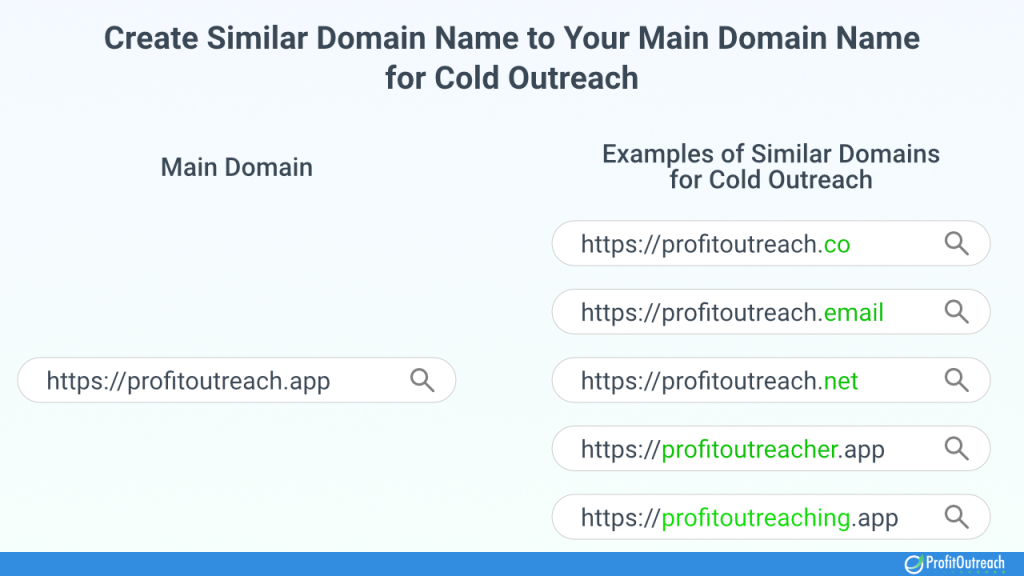
For instance, our main domain is profitoutreach.app, so we can consider alternatives like
- profitoutreach.co,
- profitoutreach.net,
- profitoutreacher.app
for our cold email campaigns.
This strategy isolates any negative impacts from cold emailing on your main domain’s sender reputation.
Additionally, ensure you implement a 301 redirect from your cold email domain to your main domain ensures that any recipients checking the legitimacy of your email can easily find your primary website, further establishing trust and credibility.
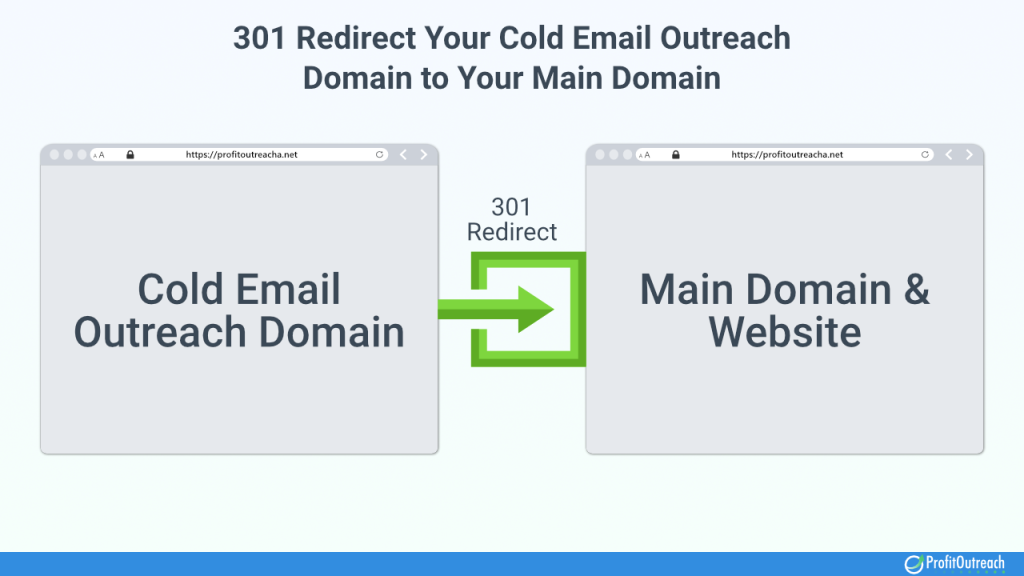
3. Have At Least 3-6 Months Old Domain Before Sending Cold Emails
The next crucial best practice for cold email deliveribality is to ensure your domain is aged enough.
Before getting on with cold email campaigns, ensure your domain is at least 3-6 months old.
This age threshold is crucial because older domains are generally deemed more trustworthy by Internet Service Providers (ISPs) and email services.
Especially, when spammers never follow this rule and start sending large amounts of cold emails since day one.
Thus, domain with some history behind it is less likely to be flagged as a source of spam compared to a newly registered domain.
This practice not only helps in improving your cold email deliverability rates but also contributes to building a solid sender reputation over time.
Patience in establishing your domain’s age can significantly impact the success of your cold email outreach efforts.
4. Follow All the Regulations and Compliance
Following and adhering to email regulations and compliance standards is essential for ethical practices and maintaining your reputation.
Luckily this is easier than it sounds and here are the key things you should follow:
- Easy to Unsubscribe: Ensure an unsubscribe option is clearly visible, allowing recipients to opt-out effortlessly.
- GDPR Compliance: For EU recipients, obtain consent before sending emails, and provide clear information on data usage.
- CAN-SPAM Act Compliance: Identify your message as an ad, include your physical address, and promptly honor unsubscribe requests.
- Avoid Misleading Headers: Use accurate from names, email addresses, and subject lines to avoid deceiving recipients.
- Easy Sender Recognition: Make it straightforward for recipients to recognize who is sending the email.
Following these standard guidelines not only keeps your cold email campaigns legal but also builds trust with your audience, enhancing overall deliverability and effectiveness.
5. Clean Up Your Cold Email List
Once you find email addresses for cold emailing, then you need to clean them up.
For cold email campaigns, it’s crucial to ensure your list is carefully curated to include only those prospects who are most likely to find value in your offerings.
This means conducting thorough research and segmentation to target individuals or businesses that align with your ideal customer profile.
For instance, if your service offers project management solutions, your list should focus on businesses or professionals struggling with project coordination and efficiency such as project managers or C-levels.
But sending cold emails to professionals that rarely or never need a project management system such as Finance or HR would only make you appear as spam.
Thus, a targeted, clean list enhances the relevance of your outreach, improving both deliverability and response rates.
To build a high-quality email list, leverage email finder tools like ContactOut to source accurate and verified email addresses. This ensures your outreach efforts are focused on the right people, maximizing your chances of success.
6. Verify Cold Email Addresses
Before launching your cold email campaign, it’s essential to verify the email addresses on your list.
This step ensures that your emails are sent to valid, active accounts, significantly reducing bounce rates and protecting your sender reputation.
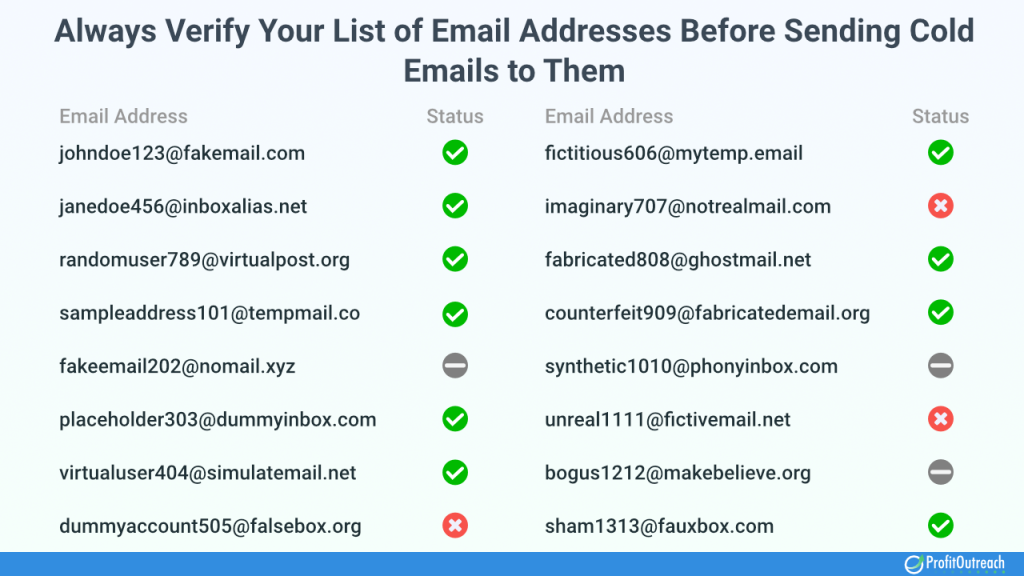
Email verification tools can automatically identify and remove non-existent or typo-laden email addresses.
For example, sending an email to “[email protected]” instead of “[email protected]” results in a bounce.
By verifying email addresses beforehand, you ensure your messages reach real people, thereby increasing the effectiveness of your outreach and maintaining a healthy email sending score.
This practice is crucial for achieving high deliverability and engagement rates in your cold email campaigns.
Fortunately, most cold email marketing tools offer built-in features for verifying email addresses before you send a cold email, ensuring the address is valid.
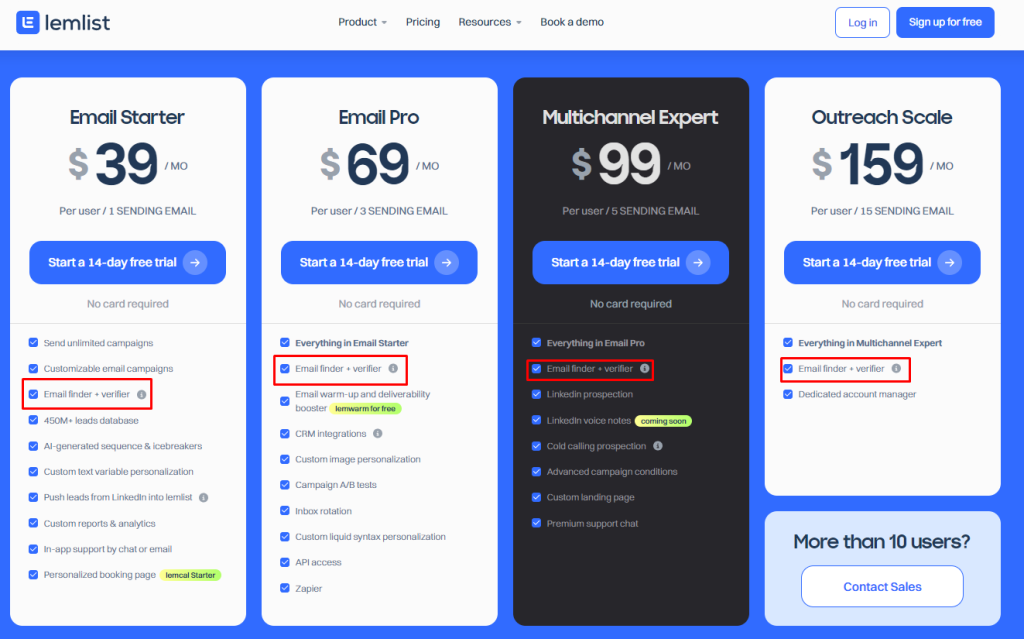
However, at ProfitOutreach, we believe in a “measure twice, cut once” approach and always run our cold email prospect email addresses through a verification service like Bouncer for an extra layer of assurance.
7. Send Only Emails to Business Emails Only
Another important practice is to focus on sending cold emails only to business email addresses.
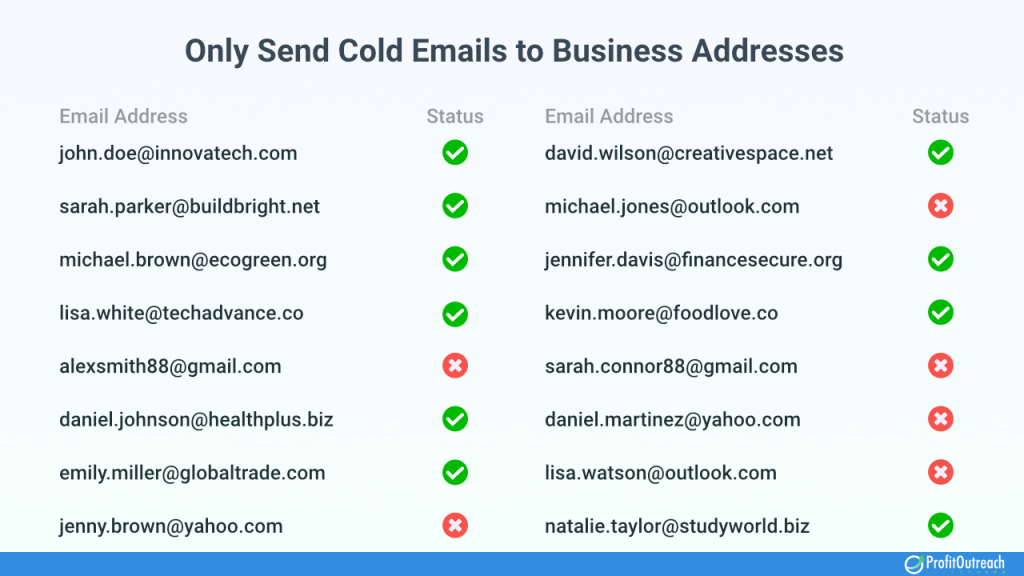
Focusing your cold email campaigns on business email addresses rather than personal ones is a best practice that can significantly enhance deliverability and response rates.
Business emails are associated with professionals in their work environment, making them more receptive to B2B offers, services, or partnerships.
Plus business emails are meant for… business. That’s right.
Thus, this approach ensures that your message is relevant to the recipient’s professional interests and responsibilities, increasing the likelihood of engagement.
For example, emails sent to a professional address like “[email protected]” are more likely to be considered and acted upon than those sent to personal addresses, aligning your outreach efforts with the context in which your prospects make business decisions.
8. Don’t Send More than Your ESP Allows
The next essential best practice that you should follow is to send only the number of emails your Email Service Provider (ESP).
Here you have a handy dandy table to better understand:
| Email Sending Provider (ESP) | Sending Limit |
| Microsoft 365/Office 365 | 10,000 per day |
| Outlook (Free) | 300 per day |
| Gmail (Free) | 500 per day |
| Gmail (Google Workspace) | 2000 per day |
| Amazon SES | 10,000 per day |
| SendGrid (Free) | 100 per day |
| SendGrid (Essentials) | Up to 100,000 per month |
| SendGrid (Pro) | Up to 1.5 million per month |
| Zoho (Free) | 50 |
| Zoho (Paid) | 300 |
| Zoho (Custom) | 2,500 |
| Sendpost (Starter) | 10,000 per month |
| Sendpost (Growth) | 600,000 per month |
| Sendpost (Scale) | Up to 1.5 million per month |
| Proton Mail (Free) | 150 per day |
| Proton Mail (Plus) | 1,000 per day |
| Proton Mail (Professional/Visionary) | unlimited |
| GoDaddy | 250 per day |
| RackSpace | 10,000 per day |
| Yahoo | 500 per day |
| BlueHost | 150 emails per hour with a frequency of 70 emails per 30 minutes. |
| DreamHost | 100 per hour |
| Yandex.mail | 500 per day |
| HostGator | 500 per hour |
| AOL | No more than 100 recipients per message or 500 recipients per connection. |
| Mailgun | 100 per hour |
Exceeding these limits can harm your sender reputation and deliverability rates.
Additionally, anything above the rate might not even be delivered to your recipients, basically wasting your opportunity to exceeding limit.
So don’t do it.
9. Verify Your Email Reputation
Regularly checking your email reputation is essential for maintaining the effectiveness of your cold email campaigns.
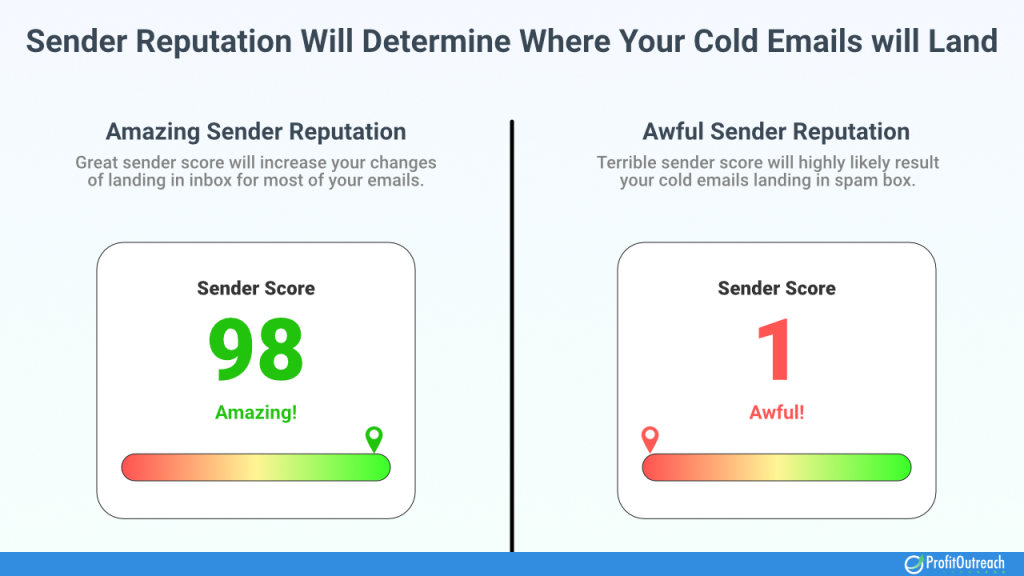
Your email reputation, or sender score, influences how email service providers view your emails, affecting deliverability.
Tools such as:
- SenderScore.org: A free service from Validity that provides an idea of how trustworthy an email sender’s IP address is. SenderScore is a number between 0 and 100 that identifies the quality of your sender reputation.
- MailTester.com: Provides a diagnostic report.
- Google Postmaster: A tool that provides information on your sending reputation, including your sending history, email volume, and bounces. It also allows users to track IP reputation in real-time by sending alerts when the reputation drops.
Other tools that can help you check your sending reputation include: BarracudaCentral or Microsoft SNDS.
10. Personalize Your Cold Email Content
Sending identical cold emails not only reduces the conversion rate but can also lead to being flagged as spam.
Therefore, it’s crucial to personalize each cold email for every recipient to make them unique, thereby avoiding potential spam flags and increasing your conversion rate.
However, moving beyond basic cold email personalization—like using common variables such as name, company name, job title, and so on—is essential.
Since these changes might only modify about 5% of the total email content, you would essentially still be sending the same message to different recipients.
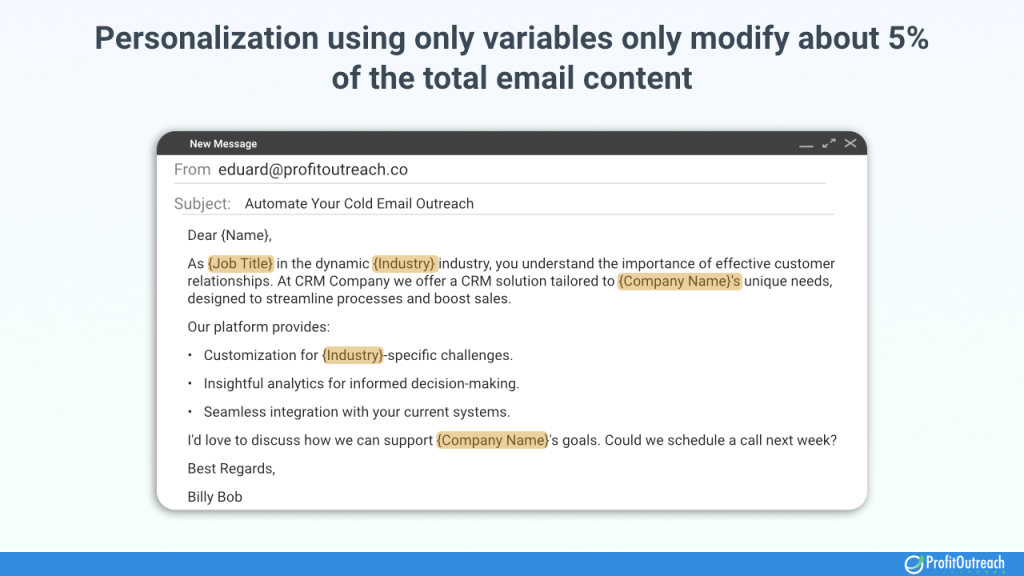
Crafting unique and personalized emails demands significant time and effort, which may not always yield returns unless you’re dealing with B2B enterprise deals worth hundreds of thousands or even millions of dollars.
To make this process efficient and effective, you can leverage tools like ProfitOutreach cold email generators.
ProfitOutreach analyze your offerings, data, and prospect data to create a personalized cold email sequence, making each email uniquely tailored for every one of your prospects.
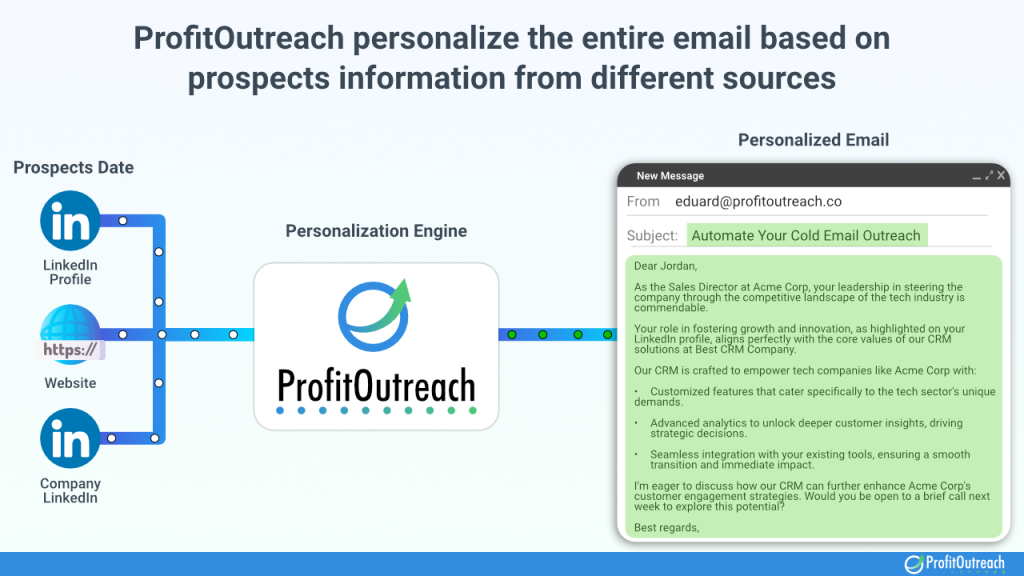
This approach not only enhances your conversion rate but also significantly boosts your ROI from cold emailing.
Furthermore, you also want to apply cold email copywriting best practices to ensure that the cold email resonates and prompts the recipients to take action.
11. Avoid Too Many Spam Words
Avoiding spam words in your cold email campaigns is crucial for ensuring your messages land in the recipient’s inbox rather than the spam folder.
ESPs associate certain words that are often used by spammers and scammers as potential red flags.
Certain words and phrases, like “free,” “guarantee,” or “no risk,” can trigger spam filters, leading to lower deliverability rates.
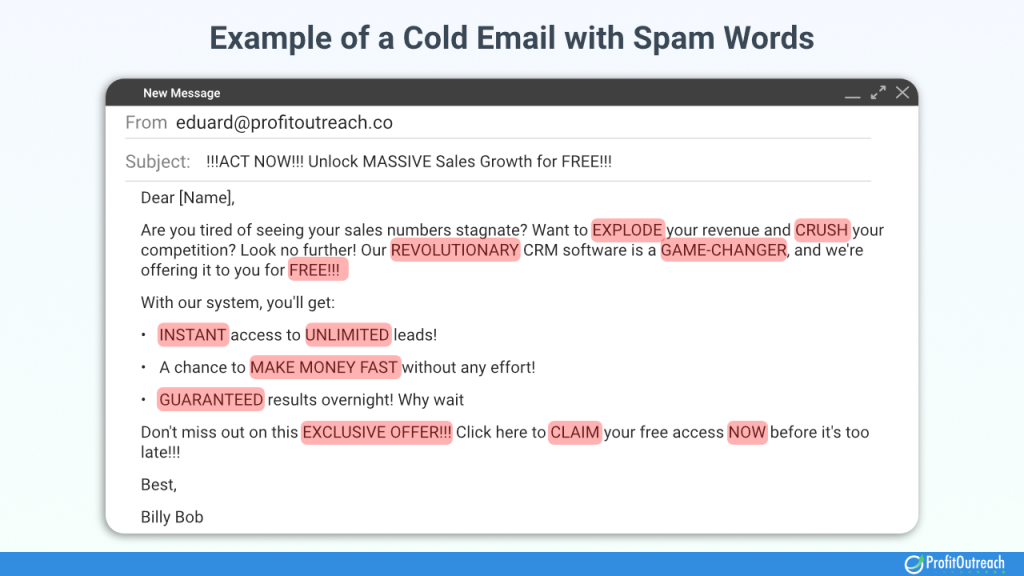
Of course, this doesn’t mean using these words will land you in a spam folder 100%, more likely, if you overuse these words or have quite a few of them in your email, you are increasing your risk.
For example, if you’re providing a free demo, then it’s fine to have an email saying that.
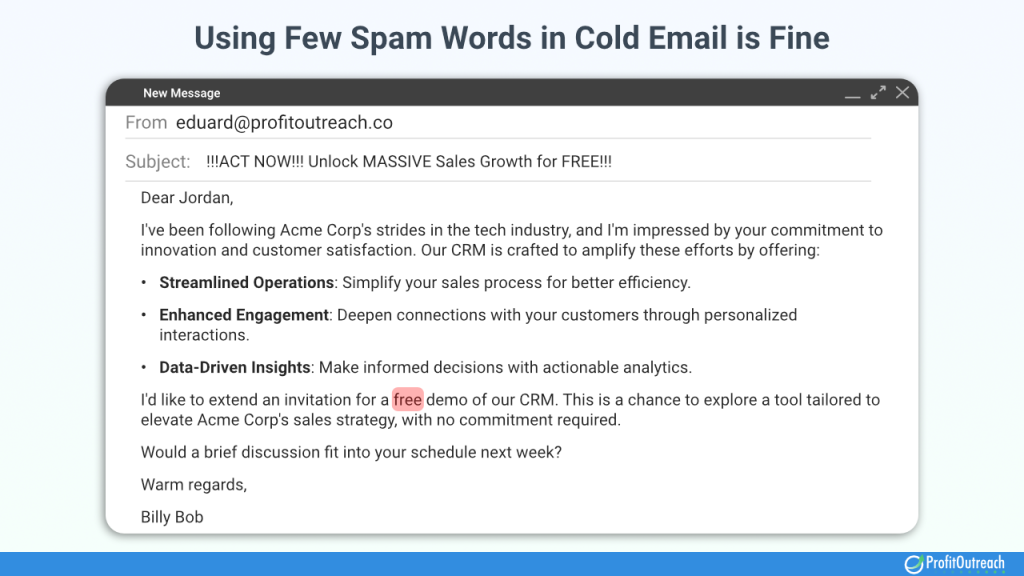
Remember, by carefully crafting your email content to exclude excessive use of these trigger words, you reduce the chances of your cold emails ending up in spam.
Additionally, this practice improves cold email open rates and also maintains a positive sender reputation with email service providers.
12. Limit Tracking of Links & Opens If You Can
While tracking opens and clicks can provide valuable insights into your cold email campaign’s performance, excessive tracking can trigger spam filters and raise privacy concerns among recipients.
To maintain trust and improve deliverability, consider limiting the use of tracking pixels and link tracking where possible.
Opt for a balanced approach that respects recipient privacy while still gathering necessary data to inform your strategy.
This practice can enhance your emails’ reception, keeping your communications welcome in your recipients’ inboxes.
13. Keep the HTML of the Email Simple (Including Signature)
Complex HTML in emails, especially with elaborate signatures, can often trigger spam filters or render incorrectly across different email clients, negatively impacting deliverability and reader experience.
To avoid these issues, opt for a clean, simple HTML layout for your cold emails.
A minimalist design ensures your message is accessible and professional across all devices and email platforms.
Including a straightforward, concise signature without excessive links or images further reduces the risk of being marked as spam, ensuring your message reaches the intended inbox.
Additionally, they look like a lot less automated compared to styled emails.
14. Start with Low Send Volume
When you start sending cold emails, it’s recommended to start with low sending volume and slowly increase it.
Here is our recommended rate of sending cold emails:
- 3-6 months: 0, only run warm-up email service.
- Week 1: 10 cold emails/day
- Week 2: 20 cold emails/day
- Week 3: 40 cold emails/day
- Week 4: 50 cold emails/day
- Month 2: 50-100 cold emails/day
- Month 3: 100-150 cold emails/day
- Month 4: 150-250 cold emails/day
- Month 5: 250-350 cold emails/day
- Month 6: 350-500 cold emails/day
This is where we would recommend stopping as sending more than 500 cold emails per day equals around 10,000-11,000 cold emails per month.
More than enough to scale your operation.
15. Use Cold Email Marketing Software, Not Email Marketing Software
For cold emailing, it’s crucial to use software specifically designed for the purpose, rather than general email marketing platforms.
Cold email marketing software is tailored to handle the nuances of cold outreach, such as personalization at scale, sending emails that appear as one-to-one communications, and managing cold email follow-ups effectively.
These platforms also typically offer better integration with email verification tools and compliance features suited for cold emailing.
Using the right tool ensures your campaigns are more efficient, compliant with regulations, and ultimately, more successful in reaching your target audience.
For us, we recommend using WoodPecker, Lemlist, Instantly, or Reply.io.
16. Mix Up Sending Times
The next essential best practice for improving cold email deliverability is to mix up sending times.
Luckily, most of the cold email platforms randomized the sending times to mimic humans and how they send emails.
It should not be every 5 seconds or every 10 seconds to send emails, but it should be randomized such as 5 seconds, 29 seconds, 2 minutes, 11 seconds, 19 seconds, etc.
Such a way will protect you from spam detection as sending in regular intervals is only done by machines and not humans.
In cold emails, irregularity is king.
17. Optimize Cold Email Content for Replies
Crafting your cold email content with the goal of eliciting replies is a powerful strategy for improving deliverability and is essential to land in your inbox and not in promotional or spam folders.
The key to email is communication.
And unlike traditional email newsletters and lead nurturing emails, cold emails need to get replies to be consistently delivered to inboxes because users did not sign up for them.
Thus, engaging, personalized content that prompts a response can signal to email service providers that your communication is welcome, enhancing your sender’s reputation.
To achieve this, ask open-ended questions, offer clear value, and make it easy for recipients to engage with a simple cold email call to action. Tailoring the message to address the recipient’s specific needs or pain points increases the likelihood of a reply, turning cold outreach into meaningful conversations and boosting the overall success of your email campaigns.
18. Write Proper Subject Lines
The subject line is the first impression your email makes and plays a crucial role in ensuring your message is opened and read.
For best cold email deliverability, craft cold email subject lines that are clear, engaging, and relevant to the recipient.
Avoid using spammy or misleading phrases that can trigger spam filters or deter recipients. Instead, focus on creating a sense of relevance or urgency, while keeping it concise and to the point. A well-thought-out subject line increases open rates and contributes significantly to the success of your cold email campaign.
19. Rotate Your Cold Email Addresses
And the last best practice for cold email deliverability is to rotate your cold email addresses.
Rotating your emails involves using multiple email addresses and domains to distribute your cold email campaigns.
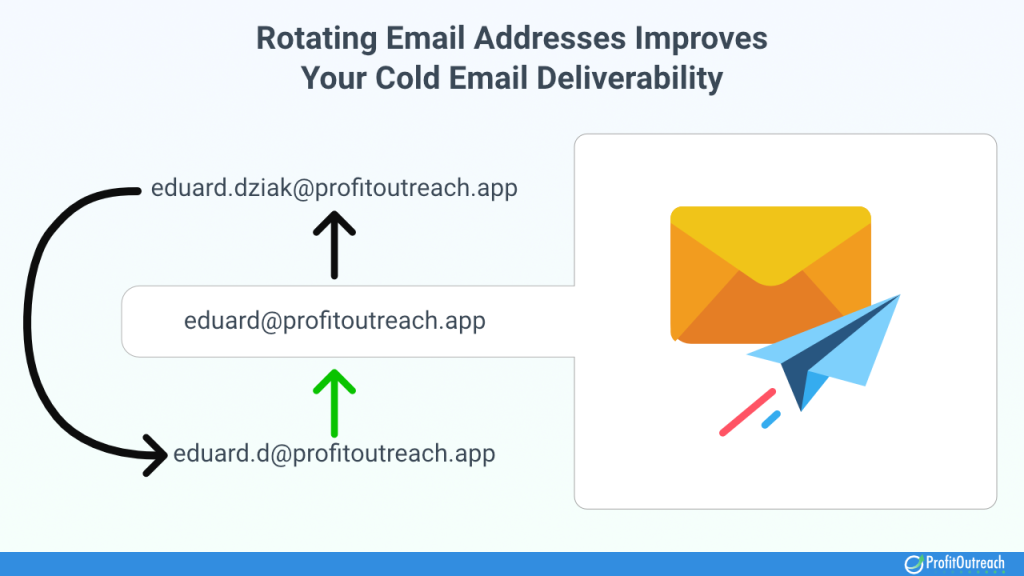
This strategy prevents any single email account from being overburdened or flagged by ESPs for sending too many messages, which can lead to blacklisting or reduced deliverability.
By spreading the load, you ensure continuity in your outreach efforts and safeguard your sender reputation as well as mimic the natural way of cold email outreach.
Conclusion
Improving cold email deliverability is an ongoing process that requires attention to detail, adherence to best practices, and continuous optimization.
By focusing on the key areas outlined in this guide, marketers can enhance their ability to reach their target audience effectively, thereby increasing the success rate of their cold email campaigns.
Remember, the goal is to ensure your emails are welcomed by recipients and ISPs alike, encouraging positive engagement and driving desired actions.
With dedication and the right approach, achieving high cold email deliverability is within reach, paving the way for successful email marketing endeavors.
FAQs about Cold Email Deliverability
In this section we’re going to answer commonly asked questions regarding to cold email deliverability:
How do I get cold emails delivered?
To get cold emails delivered, ensure your domain is warmed up, use a verified email list, adhere to email authentication protocols like SPF, DKIM, and DMARC, and maintain a clean, targeted email list. Personalize your emails to increase engagement and avoid spam triggers by keeping content relevant and concise.
What is the success rate of cold emails?
The success rate of cold emails varies, typically ranging from 1% to 5%. Success depends on factors like email list quality, personalization, and how well the offer aligns with the recipient’s needs.
How successful are cold emails?
Cold emails can be highly successful when executed correctly. Success hinges on targeting the right audience, crafting compelling and personalized content, and following best practices for deliverability and engagement. With these elements in place, cold emailing can effectively generate leads and drive business growth.
Why is cold emailing so hard?
Cold emailing is challenging due to high competition, strict spam filters, and the need for precise targeting and personalization to engage recipients who may not be familiar with your brand. Success requires overcoming these hurdles to reach and resonate with your audience.
Is cold emailing illegal?
Cold emailing is not illegal, but it must comply with regulations like the CAN-SPAM Act in the US, GDPR in Europe, and other local laws, which mandate transparency, consent, and the right to unsubscribe.
How many cold emails does it take to get a client?
The number of cold emails needed to acquire a client varies widely based on industry, offer quality, and email campaign effectiveness. On average, it might take anywhere from 100 to 1000 cold emails to secure a new client, emphasizing the importance of a strategic approach and persistence.
How many cold emails can I send per day Gmail?
Gmail allows users to send up to 500 emails per day for personal accounts and 2,000 emails per day for Google Workspace accounts. Exceeding these limits can lead to temporary restrictions on your account. Read more on how many cold emails to send per day.
Do cold emails go to spam?
Cold emails often go to spam due to factors like poor sender reputation, lack of personalization, and triggering spam filters with certain words or phrases. Ensuring compliance with email best practices can reduce this risk.
Who uses cold emails?
Cold emails are used by businesses across various industries for outreach purposes, including startups, B2B companies, marketers, and sales professionals, to generate leads, build partnerships, and increase brand awareness.
How do I send a cold email without spamming?
To send a cold email without spamming, personalize your message, ensure your email list is clean and targeted, comply with anti-spam laws (like including an unsubscribe option), and avoid using sales-heavy language that might trigger spam filters.
Related Articles:
- Best Cold Email Opening Lines and How to Write Them
- Cold Email vs Spam Email: How Not to Make Your Cold Email Outreach Become Spam
- Cold Email Statistics
- How to Create a SaaS Cold Email Strategy
- How Long Should a Cold Email Be
Related Cold Email Sequences:
- SaaS Cold Email Sequence Guide: Examples, Best Practices, and Tips
- Create Effective Product Cold Email Sequence: Examples, Best Practices, and Tips
- How to Create Effective Event Cold Email Sequence to Get More Attendees
Related Cold Email Templates:
- Best Introduction Cold Email Template
- Final Follow-Up Cold Email Template Guide: Examples, Best Practices, and Tips
- Testimonials Cold Email Template Guide: Examples, Best Practices, and Tips
